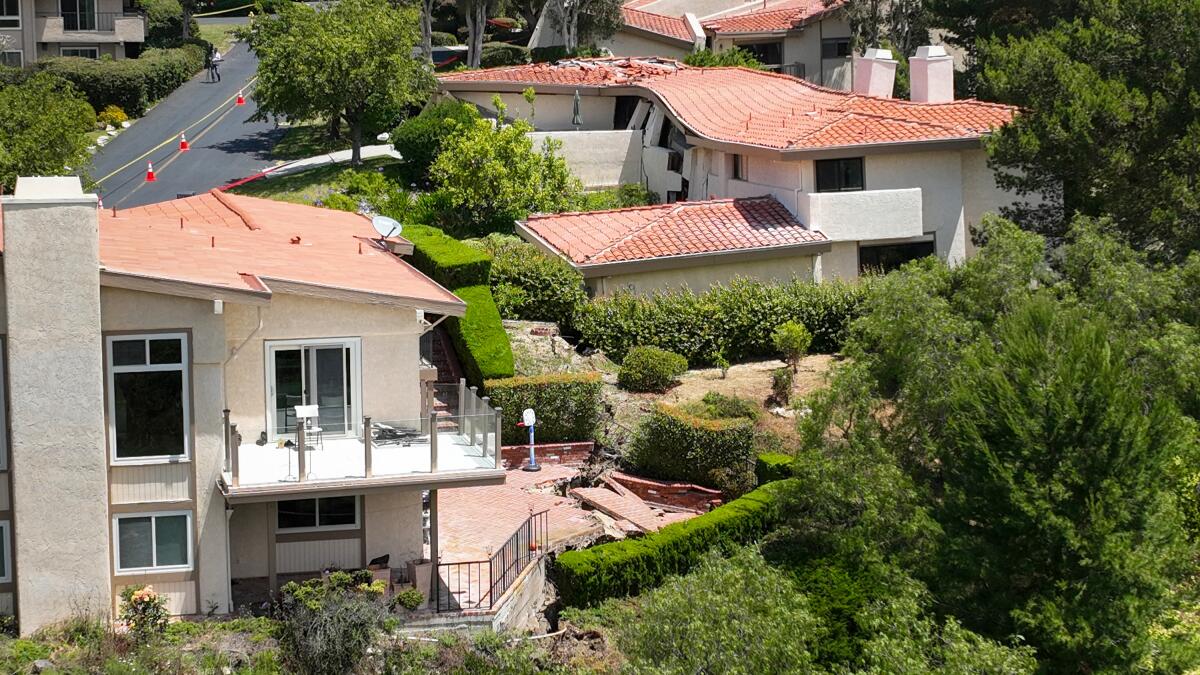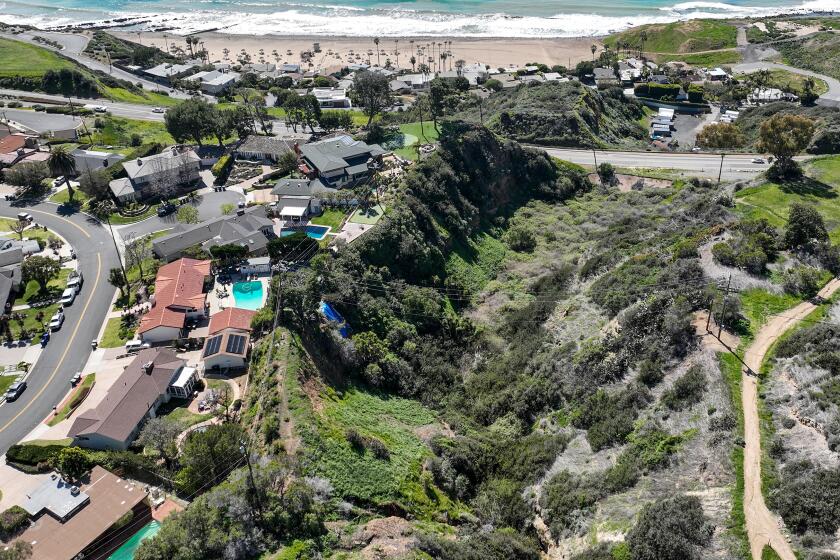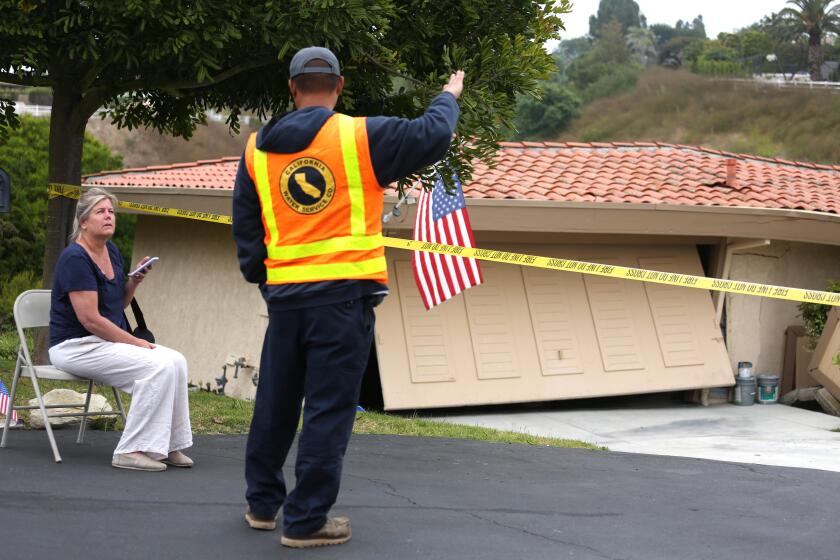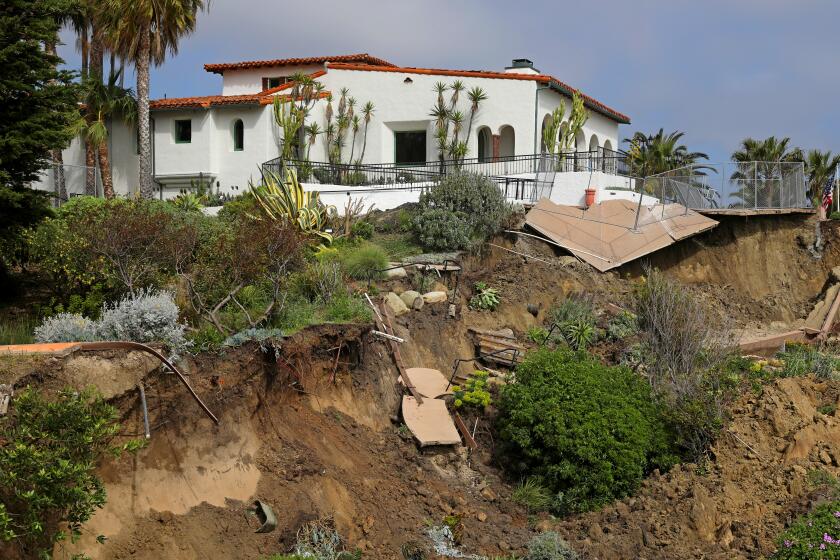What’s causing luxury homes in Rolling Hills Estates to slide down a canyon? Here’s what we know

- Share via
On Saturday night, David Zee and his family had only 20 minutes to get out of their home in a gated community in Rolling Hills Estates after the ground shifted and threatened to send it and other homes down a canyon.
Since then, the slide has gotten worse.
“It’s just amazing how quickly this all happened,” Zee, 52, said Monday morning after he returned to his street on the Palos Verdes Peninsula.
“The ground is still moving,” he said. His home is “still standing, but I don’t know.”
A dozen houses were evacuated because of a major ground shift.
Here is what we know:
What do we know about the cause?
Officials say they are still investigating.
Pete Goodrich, a Rolling Hills Estates building official, said geologists will inspect the site and decide what can be done.
The land movement “could be due to the extensive rains that we’ve had ... but we don’t know,” Goodrich said.
Rolling Hills Estates Mayor Britt Huff said officials were surprised by the destruction.
“This neighborhood was built in 1978, and it’s been solid for 45 years,” Huff said. “So we’re very much in shock by what is happening here.”
Officials said they are monitoring other homes in the neighborhood for movement.
A decades-long landslide has reshaped a 240-acre part of Palos Verdes Peninsula known as Portuguese Bend. Rancho Palos Verdes is mounting a plan to slow it.
What causes landslides?
In areas where the bedrock is very deep, rainwater can seep deep underground during multiple rainstorms. During a series of repeated heavy storms, water can eventually start to accumulate and build up pressure, The Times reported in 2017.
The pressure can destabilize an entire chunk of land, causing it to collapse downhill. Landslides can happen slowly and show warning signs, such as cracking or subtle movements, that allow people time to escape. But they also can strike rapidly with no warning, even on a rainless day months after the end of the rainy season.
Deep-seated landslides, which involve slides greater than 15 feet deep, often strike in areas with a history of wet winters. The U.S. Geological Survey has warned that such slides can become active many months after such events.
One such example occurred nearly two decades ago in Bluebird Canyon in Laguna Beach. On a foggy morning in June 2005, 17 homes were destroyed and 11 seriously damaged by a landslide that struck seemingly out of nowhere. Heavy rains had fallen from the previous December through February of that year, but no rainfall occurred just before or during the landslide.
It is still unclear whether rain was a factor in the Rolling Hills Estates slide.
The cracks in the homes, which are on Peartree Lane bordering a canyon, were visible on the outside and inside.
What are the slide risks?
The Palos Verdes Peninsula has long been prone to landslides. A dormant landslide complex has shaped the area for hundreds of thousands of years. It was reactivated 67 years ago and is threatening to destroy homes and infrastructure.
In 1997, workers from 18 small businesses evacuated two buildings in a Rolling Hills Estates office park as the walls began to warp, windows cracked and sidewalks buckled.
In the 1980s, land movement in the Flying Triangle — a sloping, sea-view area of Rolling Hills — destroyed several expensive homes.
The most dramatic slide currently in the peninsula is affecting Portuguese Bend, an area on the south side named after a whaling operation, now known for its natural beauty and native vegetation.
The geological phenomenon has hit a 240-acre area particularly hard over the last seven decades, causing fissures to open in the earth and homes to strain, buckle and drift, sometimes onto adjacent properties.
City officials are planning to mitigate the landslide before it’s too late.
“Something catastrophic is imminent,” Ara Mihranian, a city planner, told The Times in March. Since being named city manager in 2019, he has made slowing the landslide a primary focus.
The Portuguese Bend landslide was triggered in summer 1956 — nearly two decades before Rancho Palos Verdes became a city — when a Los Angeles County road crew was constructing an extension of Crenshaw Boulevard that would run from Crest Road to Palos Verdes Drive South.
The crew dug up thousands of tons of dirt for the project and dropped it on top of the ancient landslide zone, which hadn’t moved in 4,800 years. The extension was never completed, but the weight and movement of the dirt shifted the balance of the earth enough to reactivate the slide, sending the land into a slow-motion descent toward the sea.
In recent years, the landslide’s harm has been more incremental than the initial destruction in 1956 that tore up a community clubhouse and 130 area homes. City officials said the land moves sometimes horizontally, sometimes vertically. Sometimes inches, sometimes feet.
Officials said it moves at a pace of roughly 8 feet, in a southwesterly direction, per year. Over the last 15 years, sections of land have moved from 100 to 225 feet horizontally and dropped 8 to 18 feet vertically.
The most noticeable damage is to Palos Verdes Drive South — the road that winds along the coastal cliffs — warping it into a crooked, hilly mess with dips that make your stomach jump. The city has to send maintenance crews once a month to fill cracks, which costs roughly $1 million each year.
A landslide beneath the historic Casa Romantica in San Clemente underscores the threat of coastal instability exacerbated by last winter’s powerful storms.
How are things in Rolling Hills Estates?
For the record:
12:32 p.m. July 11, 2023A previous version of this story said the Rolling Hills Estates neighborhood affected by the slides is on the northern side of the Palos Verdes Peninsula. It is in the southwestern part of the peninsula.
The homes affected by the ground shift were red-tagged after firefighters and investigators found them visibly leaning Saturday afternoon. The community is on the southwestern side of the Palos Verdes Peninsula.
The homes are continuing their gradual decline down the hillside, Los Angeles County Fire Capt. Sheila Kelliher said Monday morning.
“Things are still shifting there,” Kelliher said. “The hillside is still moving. We don’t know the extent of that movement, but geographical engineers are on their way to the site to further assess the situation.”
Times staff writers Jack Fleming and Rong-Gong Lin II contributed to this report.
More to Read
Sign up for Essential California
The most important California stories and recommendations in your inbox every morning.
You may occasionally receive promotional content from the Los Angeles Times.

















